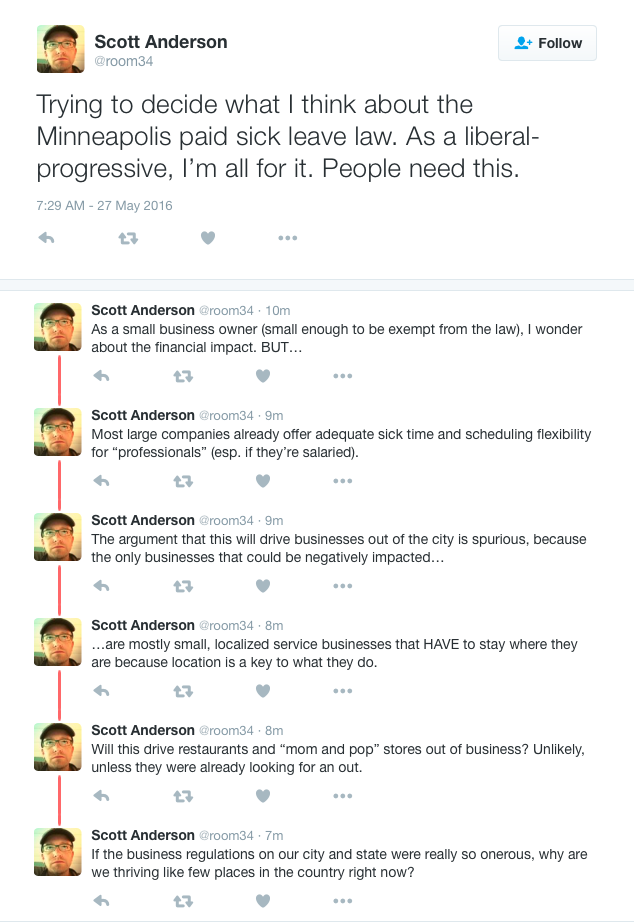It began like many other Friday evenings. Our kids were on their way to “Kids’ Night Out,” a 3-hour activity at Lake Hiawatha Park, about a mile from our house. It was going to be a more exciting evening than most, as the whole group was going to walk over to nearby Lake Nokomis Park for a small neighborhood carnival-type event that was going on there.
Meanwhile, SLP and I did what we often do for those few hours: got takeout from a Thai restaurant and went home to watch some Netflix. (What can I say? We’re well on our way to old and boring. It’s even worse if you know what we watched.)
All indications for us were that there might be some rain on the way, and we thought it might force the carnival indoors. Unfortunate, but… oh well.
Around 7:40, just as our show was ending, we got a couple of weather alerts on our iPhones — not the usual Notification Center alerts from our weather apps of choice, but the serious government/emergency alerts the cellular networks send out for things like kidnappings or natural disasters.
There were two alerts, in fact: a Flash Flood Warning and a Severe Thunderstorm Warning. I don’t worry too much about floods where we live (though I realize a flash flood is different), and although the skies had definitely darkened considerably, it wasn’t even raining yet at our house.
We took a look at the weather maps, saw a bright patch of red and orange heading our way, and decided we’d better hurry off to the park to pick up the kids. It looked like we had about 20-30 minutes before the storm would hit.
Turns out, it was just a little bit less than that.
By the time we backed the car out of the garage at about 7:45, it had started raining, and by the time we had gone the mile to Lake Hiawatha (calculating that they had either canceled their plans to go to Lake Nokomis, or that they would have already returned by now) the torrents were unleashed and the trees were whipping in the wind.
We were drenched as we ran to the door of the park building. Locked. No one inside. Damn. They were at Lake Nokomis after all.
The storm was coming on fast, so we ran back to the car and prepared to high-tail it to Lake Nokomis, a trip that was made considerably longer by the fact that the main street between the two parks, 28th Avenue, has been torn up for weeks while CenterPoint installs new gas lines.
But that didn’t really matter. By the time we had gone a block and a half from the park, cars ahead of us at the intersection of 42nd Street abruptly stopped. Cars going on 42nd Street were stopped too, pointing in various unexpected directions.
Then, I saw it. Just ahead on the next block, a large piece of a tree — larger than the small Prius we were driving in, in fact — flew across the street about 20 feet in the air. I looked down 42nd Street and saw more trees down in the road.
Cars around us were stopped, but I had no intention of staying there! I carefully made my way around the obstacles — stopped vehicles and giant tree limbs — and drove on another block. I turned and raced down 41st Street. At least I think it was 41st Street. I wasn’t really taking the time to look.
28th Avenue was still under construction at that point, not that it would have mattered, because half a block away a giant tree was downed on top of the construction equipment, blocking the entire street.
I went on another block, and then another, turning down streets and then turning back as one street after another became impassable. All the while I was looking up, trying to make sure nothing was about to fall on us.
At one point we arrived at a dead-end street that we thought was a street some friends of ours live on, and we prepared to go to their door, but it wasn’t their street after all, so we turned back.
Beginning to panic, we considered going to the door of one of the houses in the area that had lights on, but it didn’t seem like the right choice. While I was sure (or at least hopeful) they’d take us in, then what? Our car might have a tree land on it; we might be stuck there. Then how would we get to the kids once the storm passed?
Somehow having gotten to this point without colliding with another car, flying trees, or getting a flat tire from driving over all of the debris, I noticed we were by a school. What school, I wasn’t quite sure, and didn’t care to figure out. I realized in an instant that we were on the side of the building sheltered from the storm, and that there were no trees around. So I raced across the school’s parking lot, up near the building, where I found a small, fenced-in alcove where a number of other cars were parked. We drove through the open gate and I tucked the car into a corner.
And we waited.
We were wet, and cold, and shivering more from fear than from anything else. We turned on the radio, and listened as the announcers cracked jokes about the irony of how the storm was making it so dark on the longest day of the year.
“Sure,” I thought. “You’re comfortable and safe in your studio in downtown St. Paul. You have no idea what it’s like to be in the middle of this.”
We turned the radio off.
We checked our weather apps. We wanted to call the park, or hoped they’d call us, but in our haste to leave home SLP had left her phone on the kitchen counter, and it was her number the park staff had. Well, that and my old cell number, which now rings at my office.
At this point I finally pieced together the clues that we must be at Roosevelt High School. I could see the lights of the football field peeking up over the side of the building. I realized that all of the other cars parked around us — empty — in the fenced-in area were neither storm refuge seekers nor school employees’ cars. We were in front of the school’s auto shop.
A few minutes later I heard a roar of an engine behind us. Someone in a black sports car was in the parking lot, squealing tires, racing back and forth, doing donuts. At once I thought both that I wished I was as carefree in the moment as they were, but also that it was idiots like that who go out in these kinds of storms and get themselves hurt or killed. We continued to cower in our little Prius, hazard lights flashing, tucked into our relatively safe little corner by the Roosevelt High School auto shop.
The National Weather Service had issued a Severe Thunderstorm Warning for our area until 8:15. We had about 15 minutes to go. I kept turning around and looking at the large tree across the street from the school, maybe 100 feet away. It was my indicator of the current wind speed. Every time its movements would slow, we’d start to wonder if, despite the still-pounding rain, maybe things had tapered off enough that we could either get home or get to the park to pick up the kids. But before we could act, the tree whipped up into a frenzy again.
So we waited.
Even in my fear and panic, I was still myself. There were two doors to the school, a few feet from each other, directly in front of us, numbered 11 and 12. I noticed, and pointed out to SLP, that the “11” was in Arial and the “12” was in Helvetica. It’s the ones. I hate how ones look in Arial. I was ready to take a picture of it to post on Instagram, but I thought better of it. SLP was shaking and upset — and so was I — and I think there was maybe even a brief flash in my mind of, “What if the worst happens to us tonight? Is this really the last statement I’d want to leave the world?”
At one point the weather seemed to have calmed enough that we could leave, but as soon as I turned the corner and was beyond the protective wall of the school, we realized that this was not over.
8:15 finally came, but the weather didn’t seem done with us yet, so we waited a few more minutes. At 8:20 we finally pulled out of the parking lot and headed towards… well, where should we go? And where could we go? We debated going home and waiting out the rest of the storm, or going to Lake Nokomis to find the kids.
We decided that we needed to go home first, because who knew if this was over, whether we’d even be able to get to the kids, etc. We knew the kids were far safer in a fallout-shelter-grade Minneapolis park building than we were in our car. I was also hoping the park staff might have left a message for us on SLP’s phone, and I wanted to at least be able to get word to them that we were OK.
I managed to navigate by a circuitous and mildly treacherous route back to 42nd Street, where this all had begun for us. In addition to the large branches blocking part or all of some streets, we noticed several uprooted trees, tipped against buildings. All of the construction signs on 28th Avenue were flattened. 42nd Street itself was relatively clear, so we got back to 34th Avenue and headed towards our house. At one point I had to accelerate and pass someone who apparently was out for a leisurely drive. As we turned onto Minnehaha Parkway, we noticed more damage, although not as bad as what we had seen a half mile to the north, until we got to the house on the corner of our street and noticed its front boulevard tree, a very large, old tree, was uprooted and on the house. At least the house appeared not to have sustained much damage, but something this close to our house? What did that mean for us?
We were lucky. We had a few large tree branches down on our driveway, but our trees were still standing and our house was intact. We got out of the car and cleared a path to the garage, parked the car and ran into the house.
I checked SLP’s phone. Two messages from the park staff, one of which had been left within a minute of us leaving the house. I called the park and let them know we were OK — and exactly what had ensued over the past 45 minutes — and that we were on our way.
I elected to take 50th Street to Lake Nokomis and loop around the back of the park building, and I’ve never so greatly exceeded the speed limit on 50th Street in my life. We were at the park within 3 minutes, and I was glad I’d taken the route I had. Just to the west, the parkway was blocked completely by a large tree, and there were a few uprooted trees in the park by the building where the kids were waiting for us. I’m not sure we’d have even been able to get through if we’d gone another way.
We ran into the building, embraced the kids, and realized that neither they nor the park staff, who greeted us with smiles and laughter, had any idea of the extent of what had just happened, nor what it felt like to witness it through a car windshield.
We rushed the kids into the car and raced back home. More storms were on the way, we had seen, and we weren’t about to repeat the last hour.
At 8:45, we were home. It was over. Barely more than an hour had passed, but it’s an hour that will be burned into my memory for years to come.
I know now just how lucky we were. We were in the middle of the storm’s path of destruction, as it was happening, in a tiny car. We’re safe, our car is fine, our house is unscathed. Many others in the city and the surrounding metro area weren’t so lucky. I haven’t heard any reports of deaths or injuries, but there’s plenty of damage, and hundreds of thousands of people were without power for at least part of the night. There were gas leaks and fires.
And there were tireless and fearless first responders — police, firefighters and EMTs — not to mention crews from Xcel and CenterPoint who were on the scene restoring power and fixing gas lines. I have rarely had more appreciation for their dedication and courage than I did last night.
This morning, SLP and I took a walk around our neighborhood to survey the damage. Our neighborhood was lucky… the damage was significantly worse about a mile to the north, and also farther to the east. But these photos show how bad it was even within a half mile of us.







